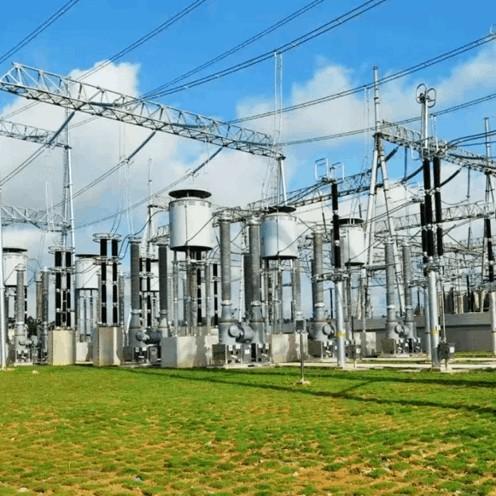1 Mga Mekanismo ng Pagkakamali ng Power Capacitors
Ang power capacitor ay pangunahing binubuo ng housing, capacitor core, insulating medium, at terminal structure. Ang housing ay karaniwang gawa sa mababang steel o stainless steel, may bushings na welded sa cover. Ang capacitor core ay inililigpit mula sa polypropylene film at aluminum foil (electrodes), at ang interior ng housing ay puno ng liquid dielectric para sa insulation at heat dissipation.
Bilang isang ganap na sealed device, ang mga karaniwang uri ng pagkakamali ng power capacitors ay kinabibilangan ng:
Breakdown ng internal capacitor element;
Pagputok ng fuse;
Internal short-circuit faults;
External discharge faults.
Ang mga internal failures ay mas mapagsasamantalang paborito sa katawan ng capacitor at, kapag nangyari, karaniwang hindi na maaaring maayos on-site, na may malaking epekto sa efficiency ng paggamit ng equipment.
1.1 Breakdown ng Internal Capacitor Element
Ang breakdown ng capacitor element ay pangunahing dulot ng mga factor tulad ng dielectric aging, moisture ingress, manufacturing defects, at harsh operating conditions. Kung ang element ay walang internal fuse, ang isang single element breakdown ay mag-short-circuit sa kanyang parallel-connected counterparts, tinatanggal ito sa voltage sharing. Ito ay nagdudulot ng pagtaas ng operating voltage sa natitirang series-connected elements. Kung walang timely fault isolation, ito ay naglalagay ng malubhang safety risks at maaaring magresulta sa catastrophic failures.Ang paggamit ng internal fuses ay nagbibigay ng epektibong at mabilis na isolation ng mga faulty elements, nagpapataas ng operational safety.
Ang capacitor breakdown ay maaaring icategory sa tatlong uri: electrical breakdown, thermal breakdown, at partial discharge breakdown.
Electrical Breakdown: Dulot ng overvoltage o harmonics, nagresulta sa napakataas na electric field strength sa dielectric, nagdudulot ng insulation failure sa defective points. Ito ay characterized ng maikling duration at mataas na field intensity. Ang breakdown strength ay malapit na related sa field uniformity ngunit less sensitive sa temperature at voltage duration.
Thermal Breakdown: Nangyayari kung ang heat generation ay lumampas sa dissipation, nagdudulot ng patuloy na pagtaas ng temperatura sa dielectric, nagdudulot ng degradation ng material at eventual insulation failure. Ito ay karaniwang nangyayari sa steady-state operation, may relatively lower breakdown voltage at mas mahabang voltage application time kumpara sa electrical breakdown.
Partial Discharge Breakdown: Resulta mula sa localized high electric fields sa loob ng dielectric, lumampas sa breakdown strength ng low-permittivity regions tulad ng liquids, gases, o impurities. Ito ay nagsisimula ng partial discharges na gradual na nagdudulot ng degradation ng insulation performance, eventually evolving into a complete through-electrode breakdown. Ang proseso ay progressive, developing mula sa non-penetrating discharges hanggang full insulation failure.
1.2 Fuse Blowing
Ang fuse protection ay isa sa pinaka-karaniwang protective measures para sa power capacitors at naglalaro ng vital role sa safe at stable operation ng compensation systems. Ito ay nakacategory bilang external at internal fuse protection.
External Fuse Protection: Kapag ang internal capacitor element ay nabigo, ang fault current sa pamamagitan ng capacitor at external fuse ay tumataas. Kapag ang current ay umabot sa rated melting threshold ng fuse, ang fuse ay init, nag-break ng thermal equilibrium, at melts, disconnecting ang faulty capacitor upang maiwasan ang paglaki ng fault.
Internal Fuse Protection: Kapag ang element ay nabigo, ang parallel elements ay discharge sa faulted element, nag-generate ng high-amplitude, rapidly decaying transient current. Ang energy mula sa current na ito ay melts ang series-connected internal fuse, isolating ang faulty element at pinapayagan ang natitirang bahagi ng capacitor na magpatuloy sa pag-operate.
Sa praktikal, ang improper fuse selection o poor terminal contact ay maaaring magdulot ng abnormal fuse blowing sa normal operation, maling tinatanggal ang healthy capacitors at nagbabawas ng reactive power output.
Kung ang internal fuses ay improperly sized at hindi maaaring isolate ang faults nang mabilis, ang fault ay maaaring lumala, potensyal na nagdudulot ng capacitor explosion o fire.
1.3 Internal Short-Circuit Faults
Ang internal short-circuit faults sa power capacitors ay pangunahing kinabibilangan ng live electrode-to-housing shorts at inter-electrode shorts. Ang mga ito ay dulot ng long-term dielectric aging, internal moisture ingress, overvoltage stress, o inherent insulation defects mula sa design o manufacturing processes, lahat ng ito ay maaaring magresulta sa puncture-type insulation breakdown at internal short circuits.
1.4 External Discharge Faults
Ang external discharge faults ay tumutukoy sa mga pagkakamali na nangyayari sa labas ng katawan ng capacitor, dulot ng mga external factors tulad ng bushing surface flashover, bushing puncture, phase-to-phase o phase-to-ground short circuits, o cracks sa porcelain bushings dahil sa mechanical stress. Ang mga fault na ito ay may iba't ibang dahilan ngunit nangyayari sa external circuitry. Maaari silang madetect at mitigated nang mabilis sa pamamagitan ng relay protection actions, routine inspections, o offline testing. Ang kanilang probability at severity ay mas mababa kaysa sa internal faults, ngunit pa rin sila nararapat na bigyan ng sapat na pansin.
2 Karaniwang Characteristics at Dahilan ng Mga Pagkakamali ng Power Capacitors
2.1 Oil Leakage mula sa Capacitor Body
Bilang isang ganap na sealed, high-field-strength, high-current device, ang oil leakage sa power capacitor hindi lamang nagbabawas ng insulation level dahil sa babaang oil level kundi nagbibigay din ng pagpasok ng moisture dahil sa babaang internal pressure. Ito ay nagdudulot ng insulation dampness, babaang insulation resistance, at ultimately internal element breakdown o kaya pa explosion.
Ang pangunahing mga dahilan ng oil leakage ay kinabibilangan ng: poor welding na nagreresulta sa inadequate sealing; aging o unevenly stressed gaskets; mechanical damage sa panahon ng transport o installation; inadequate maintenance na nagdudulot ng corrosion sa housing; at mechanical stress na nagdudulot ng pagkasira sa bushing seals.
2.2 Deformation ng Capacitor Housing
Sa normal operating conditions, ang kaunti-kaunting expansion o contraction ng capacitor housing dahil sa variation ng temperatura at voltage ay acceptable. Gayunpaman, kapag ang internal electric field strength ay sobrang mataas, nagdudulot ng partial discharge o short circuits, ang dielectric ay nag-decompose at nagggenerate ng malaking amount ng gas. Ito ay nagdudulot ng pagtaas ng internal pressure sa sealed chamber, nagreresulta sa bulging o deformation ng housing.
Kapag ang severe deformation ay nangyari, ang on-site repair ay karaniwang imposible, at ang replacement ay kinakailangan. Ang deformation ng housing hindi lamang nagpapalala sa internal insulation deterioration kundi maaari ring magdamage sa electrical structure, nagbabago ng orihinal na insulation clearances. Sa severe cases, ito ay maaaring magresulta sa bushing fracture (tignan ang Fig. 1), potensyal na nagdudulot ng explosion o fire.
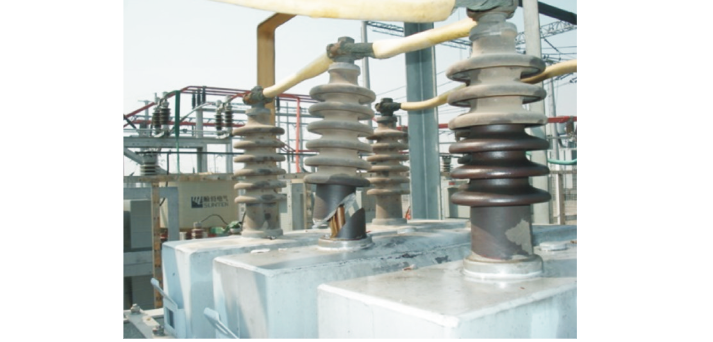
Ang deformation ng housing ay pangunahing dulot ng product quality issues, tulad ng: poor electrode o dielectric material quality; paggamit ng non-gas-absorbing insulating oil; substandard manufacturing environment o processes; residual impurities sa panahon ng production; excessive pursuit ng specific performance metrics; o housing material na too thin.
2.3 Abnormal Temperature Rise sa Capacitors
Ang abnormal temperature rise sa power capacitors ay nagdudulot ng excessive body temperature, na nag-aaccelerate ng thermal aging ng internal dielectric, nagbabawas ng kanyang insulation strength, at maaaring trigger ng partial discharge. Ang service life ng power capacitors ay pangkalahatan ay sumusunod sa "8°C rule": para sa bawat 8°C increase above the design-allowed operating temperature, ang expected lifespan ay approximately halved.
Ang abnormal temperature rise ay pangunahing dulot ng poor ventilation o prolonged overcurrent conditions. Halimbawa nito ay: unreasonable spatial layout ng capacitor room o improper placement ng ventilation equipment na nagdudulot ng inadequate heat dissipation; increased heating dahil sa overvoltage operation na nagdudulot ng overcurrent; at harmonic currents na ginagawa ng rectifier units na nagdudulot ng overheating ng capacitor. Bukod dito, ang dielectric aging, moisture ingress, o internal component faults ay maaaring magdulot ng pagtaas ng power losses, further exacerbating temperature rise.
2.4 Surface Flashover Discharge sa Capacitor Bushings
Ang mga components sa power capacitor installations ay karaniwang compactly arranged. Sa panahon ng operation, ang paligid na environment ay may mataas na temperatura at electric field intensity, nagdudulot ng madaling adsorption ng airborne charged particles. Ito ay nagdudulot ng contamination buildup sa bushing surfaces, nagdudulot ng pagtaas ng surface leakage current. Sa combined influence ng system harmonics at voltage, maaaring mangyari ang localized surface arcing sa bushing porcelain. Kapag ang contamination ay umabot sa critical level, ito ay maaaring magresulta sa surface flashover discharge, kasama ang abnormal noise. Sa severe cases, ito ay maaaring magresulta sa external phase-to-ground short circuits.
2.5 Abnormal Noise mula sa Capacitors
Ang power capacitors ay static reactive compensation devices na walang moving parts o electromagnetic excitation components. Sa normal operation, dapat silang walang audible sound. Kung ang abnormal noise ay nangyari sa panahon ng operation, ito ay maaaring nag-indicate ng high-energy partial discharge sa loob ng capacitor, at ang equipment ay dapat agad na de-energized para sa inspection.
2.6 Capacitor Rupture
Ang capacitor rupture ay isang severe failure na may malaking consequence. Karaniwang ito ay nangyayari kapag ang internal capacitor element ay nagkaroon ng inter-electrode o electrode-to-housing insulation breakdown, nagresulta sa through-fault short circuit. Ang iba pang capacitors na nasa parallel operation ay maaaring mabilis na charge at discharge sa faulty unit. Kung ang injected energy ay lumampas sa mechanical strength ng housing, ang capacitor ay maaaring ruptured at eject oil, potensyal na nagdudulot ng fire, panganib sa buong substation, at maaaring magresulta sa injury o death ng personnel.
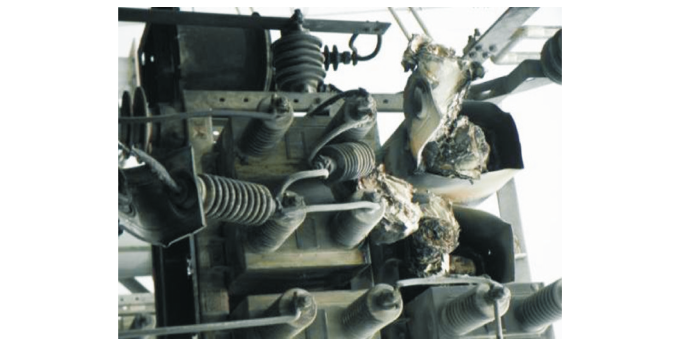
Ang cascading rupture incident na kasama ang buong capacitor bank ay ipinapakita sa Figure 2, na triggered ng internal capacitor element breakdown; ang detalyadong kondisyon ng failed element ay ipinapakita sa Figure 3.
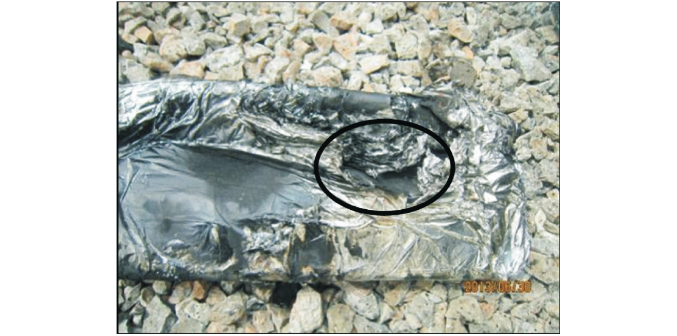
2.7 Overheating ng Capacitor Bank Connection Terminals
Kapag energized, ang power capacitor banks ay gumagana sa full load na may mataas na circuit currents. Kung ang internal connections ay may poor contact, inadequate design o installation practices, o insufficient maintenance, maaaring mag-occur ang localized overheating sa connection points. Ang prolonged overheating ay maaaring magdulot ng excessive thermal energy accumulation, potentially causing the connecting conductors to melt. Ang overheating faults sa capacitor bank terminals ay relatively common; ang kondisyon ng melted connection ay ipinapakita sa Figure 4.
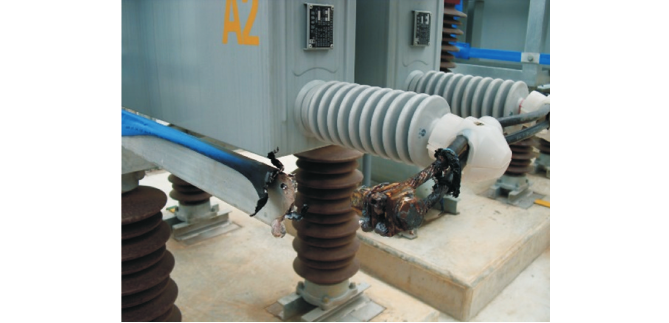
3 Preventive Measures Against Accidents
3.1 Ensuring Quality sa Equipment Manufacturing at Installation Commissioning
Ang safe operation ng power capacitors ay depende sa quality ng equipment manufacturing at installation commissioning. Sa panahon ng production, mahalaga na sundin ang process flows, gamitin ang qualified raw materials at production equipment, at i-enhance ang quality supervision sa buong proseso. Ang rigorous factory inspections ay nagse-secure ng product quality. Sa on-site installations, dapat reasonable na "phased and grouped" upang matiyak ang balanced capacitance matching between phases at sections. Bukod dito, dapat bigyan ng emphasis ang site handover at acceptance after installation upang matiyak ang installation quality at minimize ang faults sa panahon ng operation.
3.2 Improving Operation at Running Methods
Kapag ginagawa ang power-on at power-off operations para sa line loads, ang capacitor banks ay dapat sumunod sa principle ng "disconnect first, then connect," habang ang load lines ay dapat sumunod sa sequence ng "connect first, then disconnect." Ang order na ito ay hindi dapat arbitrary na baguhin.
Bago irestore ang capacitor bank operations, dapat matiyak ang sufficient discharge time. Dapat minimizahan ang frequent switching ng capacitor banks; maaari lamang ang re-closing pagkatapos ng complete discharge. Kung ang isang fault ay nagresulta sa trip ng protective devices sa capacitor bank, hindi ito maaaring reconnected bago matukoy ang cause upang maiwasan ang escalation ng accident.
Upang maiwasan ang high-order harmonics na nag-affect sa capacitor banks, dapat pumili ng appropriate reactor rates batay sa specific application scenarios. Ito ay effectively suppresses ang high-order harmonics, reduces inrush currents at overvoltage upon closing, ensuring safe operation ng buong system.
3.3 Controlling Operating Environment Temperature
Ang operational temperature ng capacitors ay direktang nag-impact sa kanilang performance at lifespan. Ang mataas na temperatura ay nag-aaccelerate ng insulation aging, nagbabawas ng service life. Kaya, mahalaga ang pag-control ng operating environment temperature. Ang indoor-installed capacitor banks ay dapat may mabuting ventilation at, kung kinakailangan, mag-install ng automatic temperature control systems. Ang outdoor units ay dapat iwasan ang direct sunlight exposure at matiyak ang proper ventilation at heat dissipation. Regularly perform live infrared thermography sa capacitor banks at associated equipment upang matiyak ang internal medium temperatures at environmental temperatures na sumusunod sa regulations.
3.4 Implementing Online Monitoring ng Equipment Operational Status
Ang pag-install ng online monitoring devices sa capacitor banks ay nagpapahusay ng real-time monitoring ng operational status, tumutulong sa prompt detection at handling ng potential faults. Ito ay kinabibilangan ng monitoring ng actual operating voltage, partial discharges, dielectric loss, capacitance, leakage current, at iba pang characteristic signals. Hindi lamang ito tumutulong sa diagnosis at isolation ng faults, kundi nagbibigay din ito ng analysis ng potential defects, achieving predictive fault warnings.
3.5 Enhancing Routine Inspection ng Equipment
Ang pag-strengthen ng routine inspection ay mahalaga upang matiyak ang normal operation ng capacitor banks. Dapat bigyan ng focus ang checking para sa deformations sa casing, oil leaks, contamination levels ng porcelain insulators, signs ng discharge, electrical distances, at environmental temperatures. Ang auxiliary methods tulad ng infrared thermography ay maaaring detect ang overheating sa connections, enabling timely maintenance at ensuring safe operation ng power capacitor assemblies.
Conclusion
Sa pamamagitan ng pag-analyze ng failure mechanisms, characteristics, at causes ng power capacitors, ang artikulong ito ay nagpopropose ng preventive measures mula sa limang aspeto: equipment at installation commissioning quality, operation methods, control ng operating environment temperature, online monitoring ng running conditions, at routine inspections. Ang mga rekomendasyon na ito ay nagbibigay ng practical guidance para sa effective application ng power capacitors.














